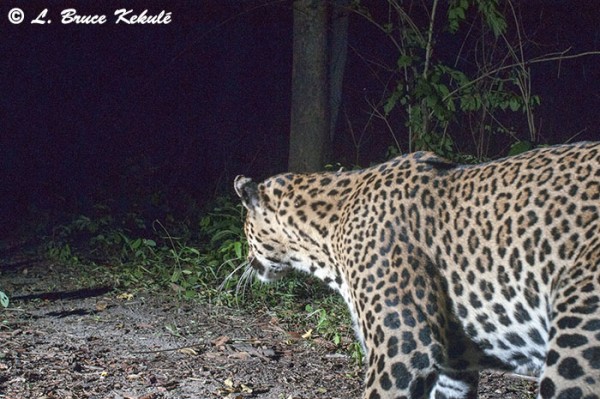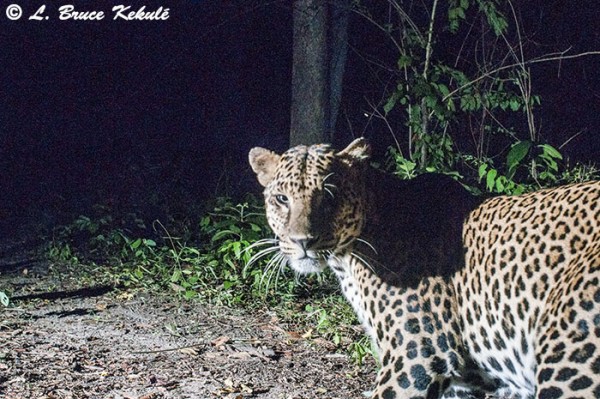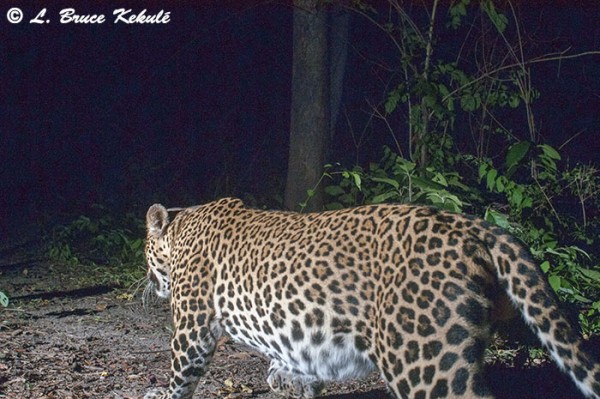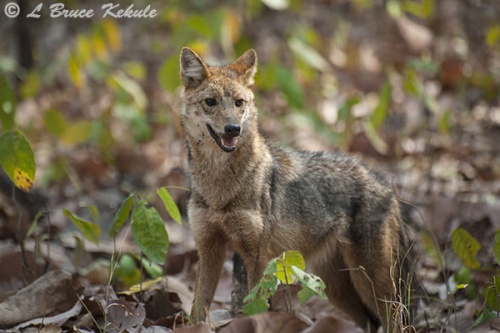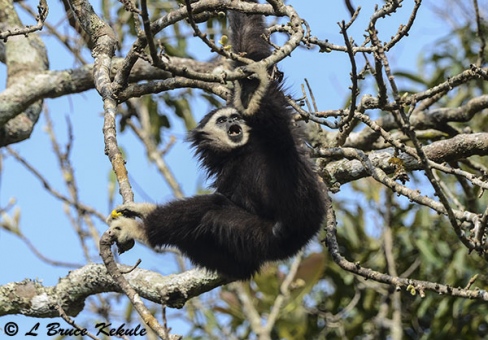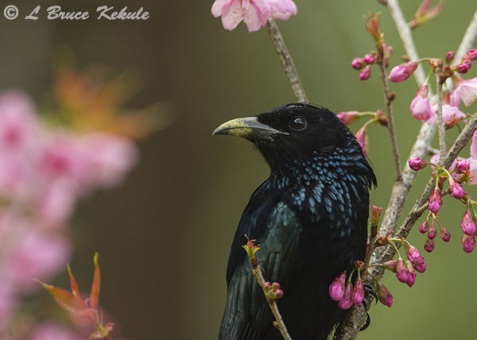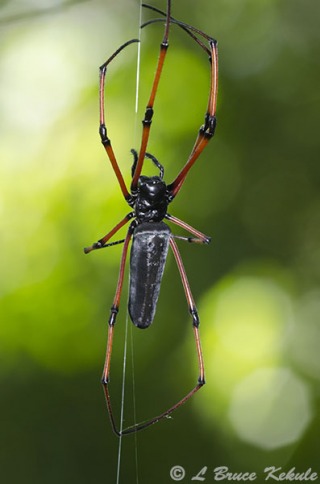Posts Tagged ‘Thailand’s wildlife’
The River Runs Wild…!
THIS POST IS THE SECOND IN A SERIES OF WILDLIFE STORIES THAT WERE PUBLISHED IN THE BANGKOK POST. IT IS ABOUT THE FIRST EDITION OF MY THIRD BOOK TITLED ‘WILD RIVERS’
Photographic book focuses through the lens of Thai national heritage on five rivers
By: PANYAPORN PRUKSAKIT
A culmination of 12 years work and including a selection of more than 300 photographs, Bruce Kekule’s Wild Rivers is truly a photographic odyssey. From the front cover, graced by the Asian tapir, an animal so rare it is considered a living fossil, one feels like this will be a truly special read. Kekule’s 20 years’ experience as a wildlife photographer, trekking and again through Thailand’s jungles, is invaluable to his epic undertaking, this his third book.
An old banteng bull and cow at a waterhole in the Western Forest Complex of Thailand
Kekule calls this a continuation of his dedication to the “Thai Natural Heritage” with Wild Rivers dedicated to His Majesty the King on his 80th birthday anniversary. On why he chose these particular rivers – the focus of this book is on fiver rivers: The Phetchaburi. Huai Kha Khaeng, Mae Klong, Khwae Noi and the Mae Ping – Kekule remarks the main reason was that they still have wildlife left, he says, as humans have been relentless in their expansion and development plans on other waterways.
Having lived in Thailand for over 40 years, he says that these rivers and the surrounding jungles are some of his favorite places in the country. A rather spiritual man, he recalls how the inspiration for his series of wildlife photography books came to him in a dream. Kekule’s passion for his career of choice is evident – one of his favorite quotes is by the Chinese philosopher Confucius, that one should choose a job you love and you will never have to work a day in your life.
An Oriental Dwarf Kingfisher in Kaeng Krachan National Park, Southwest Thailand
From the opening pages of Wild Rivers, it is clear that Kekule not only seeks the natural beauty of Thailand’s rivers with the reader, but also to inform and educate about these “natural treasures”, as he calls them. As Kekule states in his forward, “without water, there would be no life.” The book begins with a history of Thailand’s formation, and the importance of Thailand’s rivers – what Kekule calls “the lifeblood of the nation”…(as) plants, animals and humans carry out (their) daily lives dependent on water.”
Kekule’s extensive experiences is evident in the clarity, sharpness and vivid colors which define all of his photographs. But what makes Kekule’s shots truly spectacular is that the animals he captures on film are truly in their natural habitat, almost unaware of his presence.
Equally as rivetingas the photographs, which fill the book is the narration from Kekule himself, about his adventures while writing the book. Entitled “notes from the field”, he tells of his encounters with rare creatures such as the king cobra. These stories are both endearing and amazing at the same time – he recalls how he “felt extremely happy at helping to save this beautiful bird of prey from dying,” upon finding an “owl going into shock from hypothermia” and using the campfire to warm-up this creature from a certain death.
Wild pig along the river in Huai Kha Khaeng Wildlife Sanctuary
Kekule seems to have had more than his fair share of luck – indeed he concedes that he has been luckier than most other wildlife photographers, in coming upon rare animals such as the Asian tapir in the daytime. They are primarily nocturnal and hardly seen in the day, let alone photographed with good light. But he believes strongly in the “spirits of the forest”, whom he believes guide and help him. He writes how he pays his respects to the spirits – always before eating.”
However, Kekule’s career as a wildlife photographer has not been without its occupational hazards. He recalls in his book how he “became ill with the deadly Plasmodium falciparum (celebral malaria) that almost killed [him].” Kekule states that only a “medical procedure practiced here in Thailand for patients with severe malaria called a blood exchange transfusion” saved him. While he comments that he was lucky to survive”, even this experience has not kept him from capturing the wildlife of Thailand. However, he now takes some wise precautions that he did not previously adhere to, such as not photographing in the monsoon season.
Wild Rivers – 1st Edition dedicated to His Majesty the King on his 80th birthday anniversary
Kekule states how he will continue with his career for as long as he “can hold a camera and walk”, such is his determination. The most gripping and urgent message of Wild Rivers is found in the penultimate section of the book, entitled “Wildlife in Peril: Dangers threatening the natural world”. Kekule writes about how Thailand’s ecosystems are being progressively destroyed by encroachment, poachers, the black market and the traditional Asian medicine trade. He also writes how education and aid for local village Thais and hill tribe people is needed as middlemen “flash money at the people who are mostly poor and easily persuaded to break the law in order to feed this voracious [black market] trade.” Kekule outlines a step-by-step plan for the government, for “taking care of the natural resources” of Thailand, which included suggestions about budgets and addressing grassroots problems.
Kekule’s love of Thailand as a nation, and the setting for his wildlife photography adventures, is evident in every page of Wild Rivers. He hopes that his books will serve as part of education, which must be implemented in Thai schools to change the mentality towards wildlife and nature, and promote their conservation rather than their destruction. The stunning beauty of Kekule’s book and its important message can certainly not go unnoticed, if only because of the great artistry it showcases. But perhaps the reader can also take away Kekule’s message that “all humans have a right to exist, but unfortunately, not at the expense of the natural world.”
Published in the Bangkok Post’s Outlook Section on November 10, 2008. The photos shown were actually used in the newspaper article when it was published.
Nikon D700 catches an Indochinese female tiger sporting a radio collar…!
Tiger research in the Western Forest Complex (WFC) of Thailand
Indochinese tiger female sporting a ‘radio collar’ at the tiger log…!
First off, I want everyone to know that I’m not against research that is extremely important for knowledge of the natural world. The practice of studying animals and behavior is needed to understand how Mother Nature’s beings and biospheres live in a complex world. Some people might take offence to the relevant facts stated below but things need to change quickly in order to really save the tiger, and other creatures and ecosystems of Thailand’s natural heritage.
Close-up: A serial numbered tiger and the number can be seen written on the collar.
Frankly, there are some projects that are on-going and not up to standard that have caused many tiger deaths, directly and indirectly. Such is the ‘tiger research’ carried out that is mediocre to very poor to say the least. The researchers working on tigers here have a track record that simply is not acceptable…!
Many problems have come to the forefront about the system of capturing the big cats with snares and then shooting them with darts to sedate them. Some tigers have escaped the snare and ended up with a limp because of pulled joints, tendons and ligaments. This is a serious problem as the cat now cannot chase down its normal prey like deer and pigs, and quickly dies of malnutrition. Botched tiger captures using wrongly administered drugs to sedate tigers has also been noted. The tigers could not be revived and the animals were simply buried and the news suppressed.
Serial numbered tiger – #164 900 – 2014
Another problem of making broad statements about the amount of tigers in certain areas and broadcasting this plus other pertinent ‘radio collaring’ information on national TV channel is like sounding the death knoll to come and get these magnificent creatures. There are still many bad elements in our society and these cold-blooded killers think nothing about dispatching a tiger for its bones used in the making of Chinese medicine and wine. It’s all about money and human greed…!
This has also happened in India where researchers published their work in the local newspapers, and on the radio and TV how many tigers were in Panna Tiger Reserve and within one year, the cats completely disappeared as poachers moved in and systematically killed them all in one quick swoop. Tigers like all big cats, come to carrion and if a carcass is tainted with poison, it’s just a matter of time before the whole local wild feline population is wiped out. They disappeared under the forestry staff and researcher’s noses. Because it is in open forest, other animals like bears, civets, all the cats, wild pigs. vultures also perish. How could this happen..?
Other stories on the Internet can be found about tigers with collars not breeding very well was also documented in India. Finally, researcher’s laptops have been hacked into and important GPS data on tiger whereabouts was stolen. These high tech poachers can kill a population in a jiffy.
Putting collars on young tigers is a serious no-no but this has been done here in the name of research with the researchers finding the collar had stopped moving and the cub found dead having quickly out-grown the leather strap suffocating it. Another serious occurrence of taking tiger cubs out of their den for research data gathering purposes, and then coming back a second time to photograph the researchers holding the cubs. The mother tiger abandon the den and the cubs ended up dead. This is a serious breach of protocol and the National Parks law…!
Needless to say, these people continue to carry on like nothing has happened but these are facts backed-up by reliable sources and boots on the ground. And what is really worrisome is the fact that several international NGOs and a U.S. university are backing this program.
Other tribulations like bringing domestic cattle to act as ‘tiger bait’ was ongoing until recently, and who knows if any disease like ‘foot and mouth’ or ‘anthrax’ was introduced into the sanctuary during this time. The cattle were purchased locally (sometimes, diseased cows are illegally imported from nearby Burma). This baiting technique was used for several years and the researchers brought these domesticated cattle in by the truckload. A cow was then tied to a stake and a bamboo enclosure built around it with only one opening and they built scores of them in the forest. Of course hay and water were provided to the cow. A tiger would step in and maybe get snared. This practice fortunately has been suspended. This is just another breach of the law where domesticated animals are not allowed in wildlife sanctuaries that have been set aside for biodiversity and research.
The researchers already have loads of data including identifying individuals and home-range information through camera trapping, plus the data from the 8-10 collared tigers. My feeling is that the collaring process should cease as there are far to few tigers left in the wild. No amount of research can justify even one tiger getting killed in the name of science. There are only about 3,200 left in the world, and maybe less than 250 in Thailand. It is time to seriously concentrate on protection and enforcement only and less emphasis put on research. We already know there are tigers in WFC, one of the greatest tiger reserves in the world.
Most unfortunate are the old laws that apply to wildlife and protected areas that seem to perpetuate lawless people from being put away in jail. Most poachers and forest product gatherers get light fines and a slap on the wrist when apprehended in national park land, even with solid evidence. The park officials must bring all poachers to the local police station, which then starts another wheel of corruption at a higher level. If the case gets into the courts, pay-offs are used to get light sentences and sometime off ‘Scott-free’. There are very few convictions and long-term jail sentences although once in awhile, some do end-up in jail as a consequence but the ratio of convicted poachers to released offenders is small.
The biggest problem is simply there are not enough ranger personnel to look after these remaining tiger reserves and, budgets are slim and sometime non-existent. My biggest concern is that everything will come too late to save the tiger from extinction. Lawmakers and budget people need to get their head out of the sand but that will take an act of god (AOG) to get going in a culture that thrives on corruption.
One of the most important things to get established in Thailand is a dedicated ‘ranger school’ so that the ranks can be filled with well trained and equipped personnel. The present ranger numbers need to be increased by over 100%. Several revolving 5-man teams need to patrol with men always in the forest from their respective ranger stations. This is the only way to keep the poachers at bay. Again, this will basically need an AOG to get done.
Once again, I’m not against research, but a line must be drawn in the sand. Too much money and effort goes towards this activity and very little into protecting the wildlife and biospheres here that the researchers are researching. This is just not right and I for one, want to try and change things here so that wildlife at least gets a fair shake.
At the end of the day, the only thing that will help Thailand’s tigers in the long run is also a serious look into the middlemen and end-users of tiger bones and other forest products. These people must be apprehended and the masses educated to see the fallacy in using wild animal parts to cure ailments. The Asian medicine trade is still in full swing and will be next to impossible to stop.
But this practice has been going on for hundreds to thousands of years in China where the tiger first evolved two million years ago. The Chinese tiger is extinct in the wild but they now have loads of ‘tiger farms’. Unfortunately, wild tigers are the most sought after for the black market trade. It is a bad situation out there that seems to be getting worse and on the increase due to the ever-increasing population explosion. Sadly and in the long-run, the tiger will simply disappear if things do not change..!
Nikon D300s catches an Asian Leopard
A male cat shows off its family jewels…!
A male leopard with its reproductive organs in full swing…Shot No: 6.
Back at the end of June, I pulled a card from my D300s DSLR trail cam at the ‘big cat trailhead’ and when I looked, I did not see anything so I threw the card in the with the rest of my CF cards.
Shot No: 1
It was somehow put into my D3s but fortunately I did not format it. After doing some work while in the forest last week, I pulled both cards (Nikon D3s had two CF card slots) and downloaded them.
Shot No: 2
Imagine my surprise…! There was a male leopard and he had been captured at night while walking past the D300s. Where the heck did that come from…?
Shot No: 3
I guess my short-term memory is on the blink. Unfortunately, the other two flashes were dead creating a horrible shadow…!
Shot No: 4
Needless to say, I’m lucky I did not lose these shots and of course, shot No: 6 is my favorite…enjoy…!
Shot No: 5
Nikon D300s set to low continuous.
Nikon 35mm manual lens.
ƒ11 @ 1/125 ISO 400
Single SB-28 set to full (the other two flashes did not fire and were dead).
SSII sensor #6 chip – Pelican 1150.
Canon 400D DSLR catches an elephant’s trunk
A new location waiting on tiger…!
Elephant’s trunk right next to the SSII sensor hidden at the base of a tree.
It has taken awhile to get this trail cam working but it’s finally tripping well at a well-known tiger trail with plenty of battery life left in the cam and flashes after some two weeks in the field. This elephant was the first creature to cross in front of the external sensor set close to the log, and the Canon with two hard-wired SB-28s seems to be right on. I think the 400D with a Nikon 50mm ƒ1.4 manual lens looks perfect for tiger (settings: ISO 400 – ƒ8 @ 1/125). I have since added a third flash to help reduce any more shadows but that will have to wait till my next field trip next week. I look forward to checking this cam and evaluate if the third flash is really needed, and to readjust composition up a tad. Enjoy.
Canon 400D in an ‘elephant proof’ aluminum box with three Nikon SB-28 hard-wired flashes.
LBK testing the sensor and focus..!
Wild Thailand Part One and Two
For the first time, a snarling tiger shows what their reaction is to a video cam with red LEDs when actuated at night. This male tiger is a resident at this location in the ‘Western Forest Complex’…a black leopard also passed the cam several times but did not actually look at the LEDs and so no reaction was recorded.
At the second location, the tigers did not seem too bothered by the red blob…! I now have a few cams including my Nikon D700 set-up here and hopefully will catch a tiger with my DSLR trail cam…!! Please enjoy these videos and even though they are a bit fuzzy, still show Thailand’s amazing natural heritage at its best.
University of Tennessee Wildlife Presentation – November 11, 2013
This is ‘Part One’ titled ‘Chasing a Wild Dream – Predators’ of the presentation I did for the Biology Club at the University of Tennessee on Veteran’s Day, November 11, 2013. There is some old footage but some new including a black leopard in the early morning walking by my cam..one of my favorite videos…..enjoy..!
This is ‘Part Two’ titled ‘Chasing a Wild Dream – Herbivores’. Again, some old and some new….enjoy..!
A Jumping Tiger: Nikon D300s DSLR catches a big cat
The speed and reaction time of an Indochinese tiger is measured in milliseconds….!
The video is a bit raunchy and music is strong but I wanted something else for a change…! This is the most amazing behavior of a tiger I have ever seen.
I set my Nikon D300s DSLR trail cam deep in the forest at a mineral spring where all of Thailand’s large wild mammals like elephant, gaur, banteng, tapir and sambar plus others come for ‘life-giving’ minerals and a drink, and where tigers coming looking for prey.
This cam (set to manual 1/125 – ƒ8 – ISO 400) with a 35mm lens with a Snapshot Sniper SSII sensor fires-off salvos of 8 frames a second every time it records motion. The Nikon D300s was perfect for this location
I was hoping to catch a tiger and thought I might get lucky…but after going through the files, I found 13 photos of a tiger jumping away from the cam. This action footage is my best so far of the tiger in Thailand. The cat is not exceptionally sharp but movement never is and it does not have to be…..!
Amazingly, this male tiger heard the first shutter and reacted in less than three frames and started moving away in what I would like to say, blinding speed…! He looks to be mature judging from his scrotum. This place is truly the last great tiger haven in Thailand and worthy of it’s ‘World Heritage Site’ status…!
All I can say, it’s going to be tough to top this sequence….!
Enjoy…!
Asian Wildlife through the lens – “Creating conservation awareness through wildlife photography”
THIS POST IS THE FIRST IN A SERIES OF WILDLIFE STORIES THAT WERE PUBLISHED IN THE BANGKOK POST IN THEIR NATURE SECTION: ‘ASIAN WILDLIFE THROUGH THE LENS’. Text and photos © L. Bruce Kekule
“The present government should take a positive interest in preserving what remains of the Kingdom’s natural treasures before it’s too late”
“Before World War II, 75% of the nation was still covered in pristine forests”…!
“What remains is still worth saving”…!
Asiatic jackal by the side of the road in Huai Kha Khaeng
Thailand’s wildlife and forests has evolved over millions of years into some of the most beautiful and interesting in the world. Photographing these ecosystems and rare animals such as the Siamese crocodile, tiger, leopard, gaur, banteng, wild water buffalo, elephant and tapir, plus a multitude of other mammals, birds, reptiles, amphibians, spiders and insects in their natural habitats is a daunting task to say the least. A multitude of different aspects contribute to the difficult and sometimes dangerous pastime of wildlife photography.
Gibbon calling during the morning in Huai Kha Khaeng
Probably the most prominent is the ever-increasing human population and social ills like poaching, gathering and encroachment in the protected areas. This alone has taken its toll and the country’s wild flora and fauna, from under the sea to the highest mountains, are in serious jeopardy with a slim chance of recovery to the magnificent ecosystems of the past. However, not all is lost and the present generation should take a positive interest in preserving what remains of the Kingdom’s natural treasures before it is too late.
Nature photography is one of the best ways to record and promote wildlife conservation awareness. Wildlife photographs create a mental image that can improve one’s love and understanding of the wonderful world of nature. Many people in the cities have a misconception that Thailand’s wildlife and forests has diminished to the point of no return, or has disappeared into the depths of extinction. This is unfortunate and needs constant education and media projection to uplift the people’s knowledge that many species do in fact, still survive.
Sambar with a blue magpie feeding on ticks in Huai Kha Khaeng
Low densities at many sites depleted over the years by poaching and encroachment before any form of protection was implemented is probably one of the main reasons. Human pressure and the Asian traditional medicine trade are directly responsible for the disappearing wild species. The black market trade in wildlife seems to be on the increase and the authorities are continually working to eradicate this destructive illegal business.
Before World War Two, 75 percent of the nation was still covered in pristine forests. Barely 30 percent survives today and most of these are seriously degraded. Wildlife has become scarce and extremely elusive and hence, difficult to photograph. With no subjects, it can be a tough assignment to capture wild creatures that were once quite common. Knowing where to go with the right equipment is just part of the process. Many other aspects are also important and I will try to pass on some of my experiences to those who desire to try their hand at nature/wildlife photography.
Sambar doe on the run in Huai Kha Khaeng
A few protected areas still remain fairly intact with good densities of flora and fauna. Prey species are abundant and carnivores thrive. These havens for wildlife include time honored Huai Kha Khaeng and Thung Yai Naresuan wildlife sanctuaries, Thailand’s top nature reserve and a World Heritage Site. Due to its size (more than 6,000 square kilometers) and biodiversity, this site is absolutely the best tiger habitat left in the Kingdom. It must be saved at all costs for present and future generations.
Kaeng Krachan and Kui Buri national parks further south along the western border with Burma still have very good ecosystems with an abundance of flora and fauna. Other protected areas include: Khao Yai, Thap Lan, Pang Sida national parks in the northeast; Khao Ang Rue Nai and Khao Soi Dow wildlife sanctuaries in the east; Sai Yok, Erawan, Sri Nakarin national parks and Salak Phra Wildlife Sanctuary in the west; Khao Sok National Park, and Khlong Saeng and Khlong Nakha wildlife sanctuaries in the south; and finally, Tarutao National Park and Hala Bala and Budo wildlife sanctuaries in the deep south all have wildlife and make good photographic destinations. However, the security is not too good at the moment and maybe it would be better to wait until things improve for these southern nature reserves.
Gaur herd at a mineral deposit in Huai Kha Khaeng
Wildlife photography is a difficult hobby or profession to become proficient. Years of trial and error, lost shots, bad exposure, out of focus, no wildlife subjects, equipment failure, expense and many other intricate problems make things difficult for the wildlife photographer. Travel plans and permission to enter some of the sensitive protected areas is a hurdle that must be crossed before any photographs can be taken. But where there is a will, there is a way and the difficult can be overcome.
Cameras and lenses in the professional range are expensive but amateur equipment can also provide satisfactory results. Modern technology like the Digital Single Lens Reflex (D-SLR) is now the ultimate and both Nikon and Canon remain the most popular brands for variety (beginner to professional both in lenses and cameras). Other makes like Sony, Pentax, Olympus and Sigma also offer very good equipment. Aftermarket lenses from Sigma, Tamron, and Tokina cost less than the top brands but produce satisfactory to very good photographs.
Spangled drongo in Doi Chiang Dao Wildlife Sanctuary
Another form of wildlife photography is the use of infrared camera traps that allows one to capture illusive and rare animals, plus new digital cameras show results in real time. Readymade camera traps are available and a quick search on the Internet will show dozens of makes and models.
Female tiger camera trapped in Huai Kha Khaeng
The use of a photo-blind is very important as is self-control and patience, which comes with practice and a desire to get a photograph of nature’s creatures. Long stints in the blind and hot weather are something that comes with practice. Wildlife encounters are usually brief and one must always be ready with camera in hand ready to shoot on a moments’ notice.
Black orb spider along a trail in Huai Kha Khaeng
No two days are alike in the natural world and opportunities must be taken then and there if one is to be a successful wildlife photographer. Finally, share your photographs with as many people as possible in order to send a message to all that nature is truly worth saving for the future.
Published in the Bangkok Post on February 27, 2013 in the Life – Nature section…!
The ‘Little Elephant Slider’
A 3-month old baby elephant slides in on the trail to a waterhole deep in the forests of western Thailand. This family unit is also made-up of several mature females and younger juveniles.
Chasing a Wild Dream
A video about Thailand’s Amazing Wildlife in the Western Forest Complex. From wild elephants to green peafowl, this film shows the world the wildlife in the Kingdom’s protected areas, and the need to save this wonderful natural heritage for present and future generations to come.
In the heart of Southeast Asia, the Kingdom is blessed with some of the best and last remaining examples of Asian animals and ecosystems that harbor the tiger, leopard, elephant, gaur, banteng, wild water buffalo, tapir, sambar, muntjac, gibbon, green peafowl, hornbill, plus thousands of other amazing creatures and biospheres that have evolved over millions of years and show-case Mother Nature and her magnificent beauty…!










